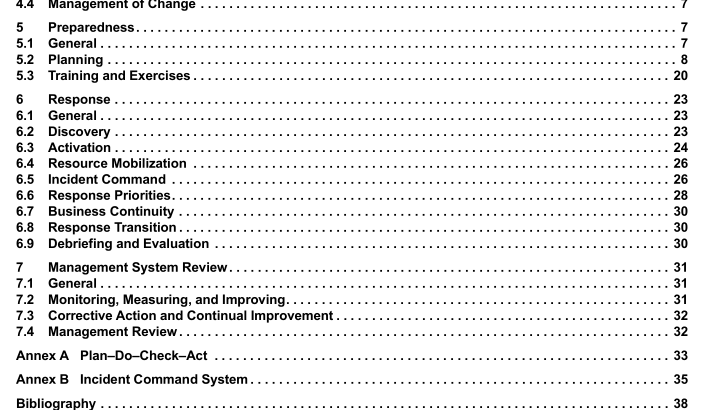API RP 1174:2015 pdf free download.Recommended Practice for Onshore Hazardous Liquid Pipeline Emergency Preparedness and Response
5.2.14 Business Impact and Continuity
5.2.14.1 Business Continuity Plan Objectives The operator should have a Business Continuity Plan, which focuses on preserving critical processes and day-to-day operations during major incidents or disasters and minimizing financial impact on the business. The objectives of a Business Continuity Plan should include the following:
— maintaining viability of the business and continuing to provide a minimum acceptable level of service;
— managing and controlling risks;
— minimizing interruption to operations;
— coordinating the restart plan and, when appropriate, returning to the same service level as prior to the business interruption. N
OTE During emergencies, suspension or reduced levels of service in some processes, operations, or functions may be acceptable for a short time period. However, as the incident timeline progresses or is affected by other ancillary issues, suspended or reduced levels of service can threaten the operator’s capability to conduct business and support customers.
5.2.14.2 Business Continuity Plan Content The Business Continuity Plan should:
— identify key critical business processes, functions, and systems;
— document plans to minimize impact to each process, function, and system; and
— concentrate on impacts that directly affect the operator, such as personnel resourcing, loss of infrastructure (e.g. office locations, equipment, operations, information services or IT infrastructure and applications, etc.), or inability to deliver product or services.
NOTE The operator may prepare a Business Continuity Plan as part of a larger emergency management system or as a supplemental document.
5.2.15 Corporate Crisis Management The operator should establish a Corporate Crisis Management Plan that:
— provides identified executive leadership with the information needed to respond to pre-determined trigger events, or incidents that have the potential to develop into a crisis if not addressed;
— enables the operator to respond in a safe, timely, effective, and organized manner by establishing clear roles and responsibilities for executive leadership, including boundaries among business units, IMTs, and corporate headquarters;
— guides the focus of effective executive leadership to avoid becoming over involved in the operational response; and
— provides clear definition of the difference in roles and responsibilities for the IMT, which is focused on managing the incident itself, versus the crisis management team, which is focused on managing the effects of the incident.
5.2.16 Plan Document Management In accordance with Section 4, the operator shall establish and implement a process that documents the location of the Response Plan, how the Response Plan can be accessed, how changes or modifications to the Response Plan are managed and communicated to stakeholders, and how previous versions are removed or destroyed to prevent access to older content. This process shall address complex facilities that share regulatory agency requirements and how the Response Plan is communicated to all parties. In addition, the process should identify the parties responsible for plan document management. The operator shall update the Response Plan and submit it to the Department of Transportation (DOT) if any of the following occur:
— change in qualified individual;
— change in WCD;
— change in commodity transported (such as a change from crude to refined products);
— new construction or purchase in a response zone not covered by the previously approved plan;
— revisions to the applicable ACPs or NCP that have significant impact on the equipment appropriate for response activities;
— addition or revision of an OSRO;
— revision of emergency response procedures;
— change of circumstances that can affect full implementation of the Response Plan.
The operator should provide the Response Plan to response agencies upon request. The operator should consider risks associated with sharing security sensitive information. The operator may direct a requesting response agency to the DOT.
5.3 Training and Exercises
5.3.1 General The operator shall develop a training and exercise program for emergencies. The operator shall use National Preparedness for Response Exercise Program (PREP) Guidelines to satisfy exercise requirements. The operator’s training and exercise program should meet the unique needs of the operator. The operator may consider using the Homeland Security Exercise and Evaluation Program (HSEEP).API RP 1174 pdf download.API RP 1174:2015 pdf free download
